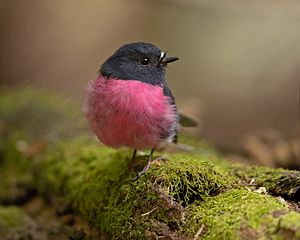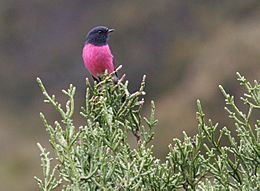Pink robin facts for kids
Quick facts for kids Pink robin |
|
|---|---|
 |
|
| Conservation status | |
| Scientific classification |
The pink robin (Petroica rodinogaster) is a small, colorful bird found in southeastern Australia. It lives in cool, temperate forests.
This bird is a type of passerine, which means it's a perching bird. Like many other bright robins, the pink robin shows sexual dimorphism. This means males and females look different.
Pink robins are about 13.5 cm (5.3 in) long. They have a small, thin, black beak, dark brown eyes, and black legs. The male has a bright pink chest and a white spot on its forehead. Its back, wings, and tail are grey-black, and its belly is white. The female, however, is mostly grey-brown.
Contents
About the Pink Robin's Name
The pink robin was first described by a Belgian scientist named Auguste Drapiez in 1819. It belongs to a bird family called Petroicidae, which are the Australasian robins.
The scientific name for the pink robin is Petroica rodinogaster.
- The first part, Petroica, comes from ancient Greek words: petros meaning 'stone' and oikos meaning 'house'.
- The second part, rodinogaster, also comes from ancient Greek. Rhodinos means 'pink' and gaster means 'belly'. So, its name literally means 'stone-house pink-belly'!
Scientists have studied the DNA of these birds. They found that the pink robin is closely related to the rose robin. They are both part of the Petroica group.
What the Pink Robin Looks Like
The pink robin is about 13.5 cm (5.5 in) long. As mentioned, males and females look quite different. This is called sexual dimorphism.
- The male pink robin has a dark, blackish-grey head, throat, back, wings, and tail. Its chest is bright pink, which fades to white on its lower belly. It also has a clear white spot on its forehead.
- The female is mostly dark grey-brown on top. She has two buff-colored stripes on her wings. Her underside has a pinkish tint.
Both males and females have black beaks and feet, and their eyes are dark brown.

Where Pink Robins Live
Pink robins live in the forests of southern Victoria, parts of South Australia, and New South Wales. They are also found in Tasmania. They prefer cool, temperate forests.
Reproduction and Life Cycle
Pink robins usually breed from September to January. The female builds a very neat, deep, cup-shaped nest. She uses moss for the main structure. She also uses spider webs, feathers, and fur to hold the nest together and make it soft inside.
Nests are usually placed in a tree fork, up to 5 m (15 ft) above the ground. The female lays a clutch of three or four eggs. The eggs are about 18 by 14 mm in size. They can be grayish, greenish, or bluish-white. They have dark brown and lavender spots, usually more concentrated at the larger end of the egg.
What Pink Robins Eat
Pink robins eat a variety of small creatures. Their diet includes different kinds of spiders and insects. They also eat caterpillars, ichneumon wasps, beetles, flies, and ants.
See also
 In Spanish: Petroica encarnada para niños
In Spanish: Petroica encarnada para niños


